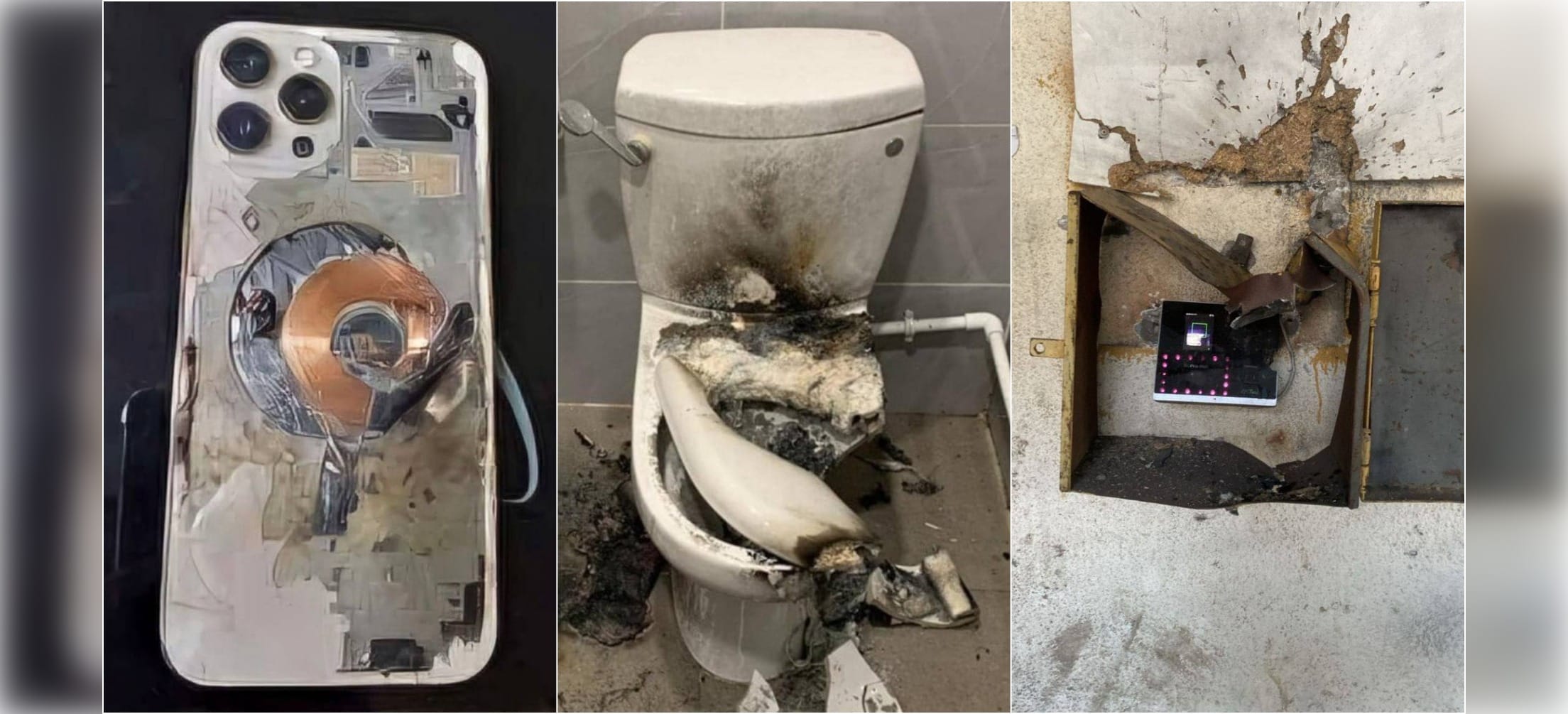In September 2024, Telegram channels and news publications began to circulate photographs of various objects that allegedly exploded in Lebanon at the same time as pagers and walkie-talkies. We have verified the accuracy of such messages.
On September 18–19, photographs of an exploding iPhone, toilet and intercom began to circulate in the Russian-language segment of Telegram. Captions for these images indicate that they were taken in Lebanon on the same days that hundreds of pagers and other communications equipment were detonated there. The authors of some publications specified that all devices with lithium-ion batteries exploded in the country.
On September 17 and 18, communications equipment used by members of the terrorist organization Hezbollah were massively exploded in Lebanon. By data Lebanese Ministry of Health, as a result of the incident, 37 people were killed and about 3,000 more were injured. Hezbollah accused in the attack Israel, but President Isaac Herzog a few days later publicly rejected this country's involvement in the bombings. The New York Times, citing 12 current and former Israeli intelligence and defense officials writesthat the explosive pagers that detonated on September 17 were supplied to Hezbollah by a company registered in Hungary by the Israeli intelligence services and created specifically for the operation. September 18 in Lebanon exploded mainly walkie-talkies, which were also used by members of the group.
iPhone
A photo of an iPhone allegedly exploding in Lebanon was posted on Telegram channels “Ivan Utenkov | Kursk"(156,000 views at the time of writing this analysis), "Olga Skabeeva"(100,000), "Country politics"(92,000), "Dmitry Gordon" (63,000) and "Voenndelo (Military Affairs)» (55,000), as well as media such as RT And "Constantinople"
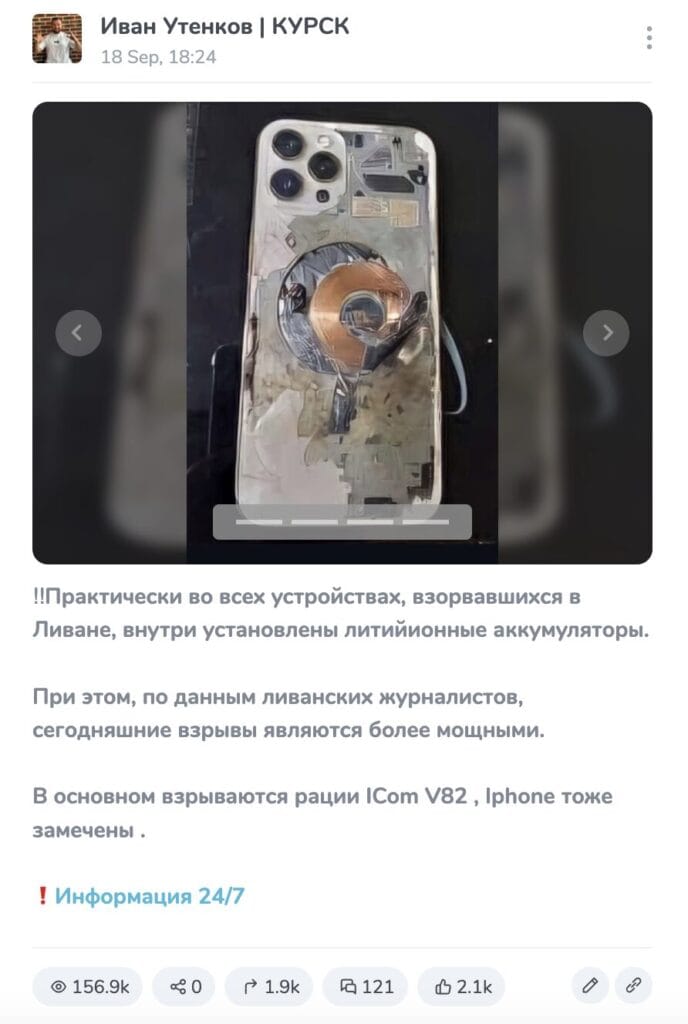
A photo of an iPhone, presumably with a burnt-out battery, began to circulate after the second series of explosions. All such reports about explosions of Apple equipment in Lebanon are accompanied by the same photograph, while photo and video recordings of the consequences of the explosion of pagers can be found find dozens. It is unlikely that only one iPhone detonated, or that there was a photograph of only one such incident.
Moreover, the iPhone explosion does not fit into the overall strategy of the operation, which The New York Times and other media write about. Hezbollah is active used pagers to avoid surveillance by Israeli intelligence services. In February 2024, group leader Hassan Nasrallah ordered Hezbollah fighters to get rid of mobile phones, destroy them or hide them in safe places.
The Taiwanese company Gold Apollo, whose name was indicated on the exploded pagers, publicly statedthat did not release them. According to the company, the AR-924 devices were manufactured by the Hungarian company BAC Consulting, to which Gold Apollo sold the right to use its trademark in certain regions. At the same time, Apple, which produces iPhones, did not announce explosions of its devices in Lebanon in September.
A reverse image search on Google showed that the viral photo was published back in 2021. For example, she appeared in a note from the Egyptian publication Cairo 24. The article says that this iPhone exploded in Cairo while connected to a charger. This caused a fire in the apartment where the owner of the gadget lived. The publication contains photos of the iPhone from other sides.
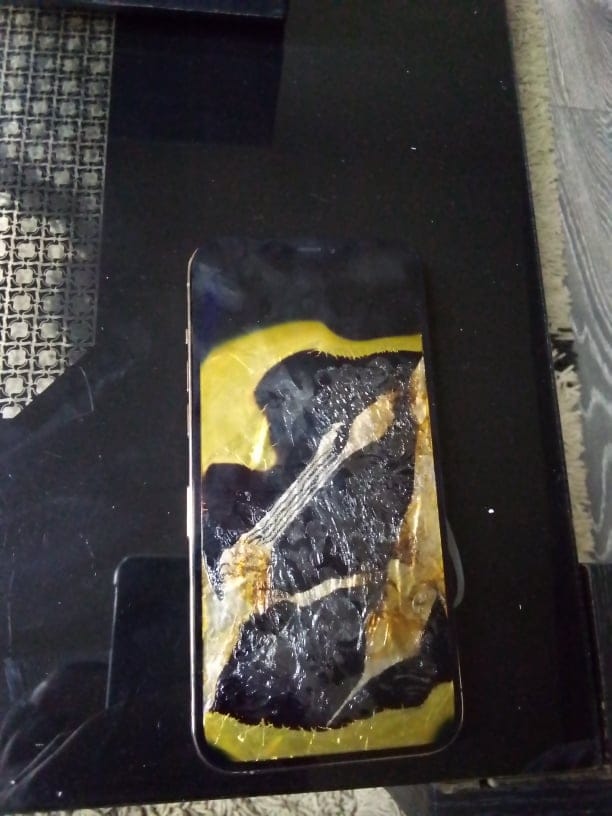
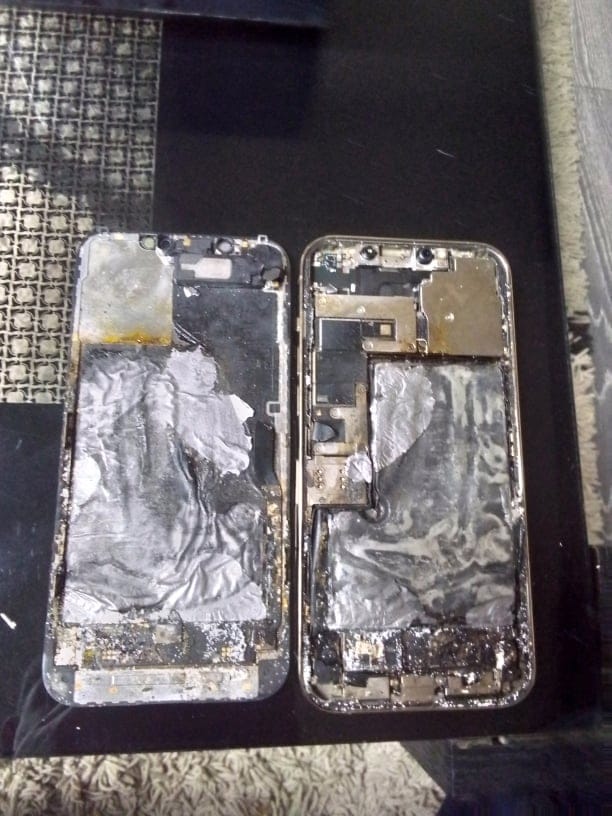
Thus, the photo used as confirmation of the 2024 iPhone bombing in Lebanon was actually taken three years earlier in Egypt.
Toilet
Amid the explosion of pagers and walkie-talkies in Lebanon, X users distributed photo of a partially destroyed toilet, claimingthat explosives were also planted in Japanese heated toilets. Other bloggers suggested that the plumbing was damaged while being used by a Hezbollah member and that a communication device in his pocket exploded.
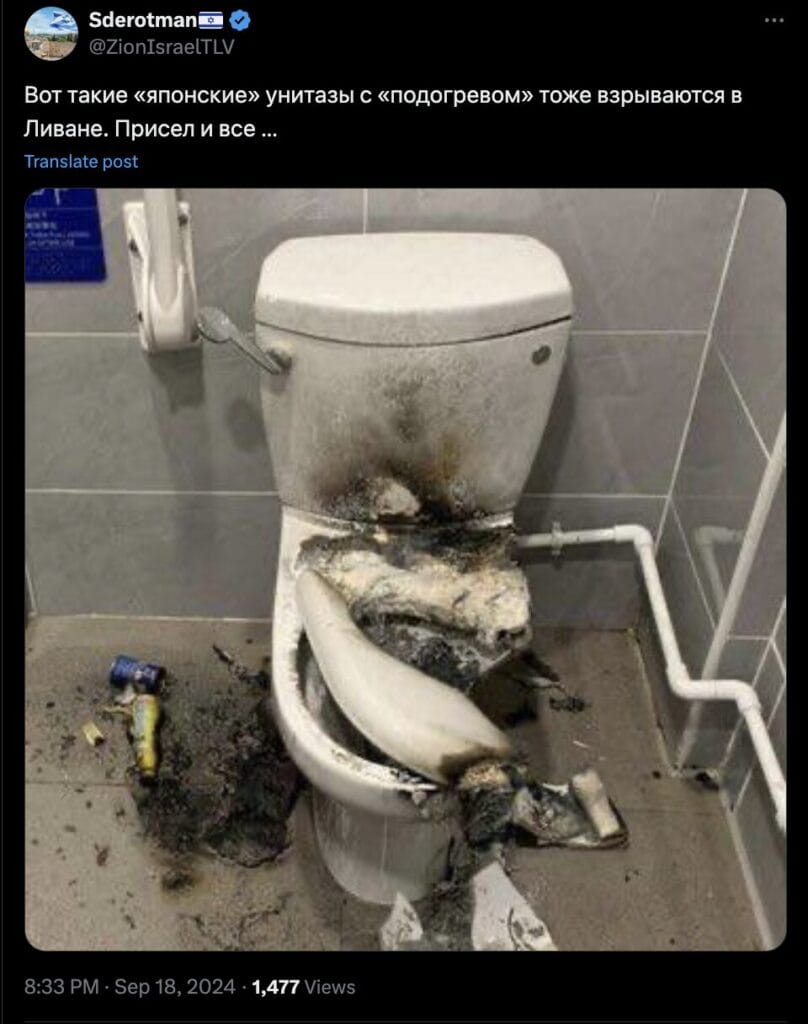
A reverse image search revealed that the photo was first published by a newspaper more than four years ago. South China Morning Post. On 27 January 2020, an improvised explosive device detonated in a public toilet at King George V Memorial Park in Hong Kong. The photo shows the consequences of what happened.
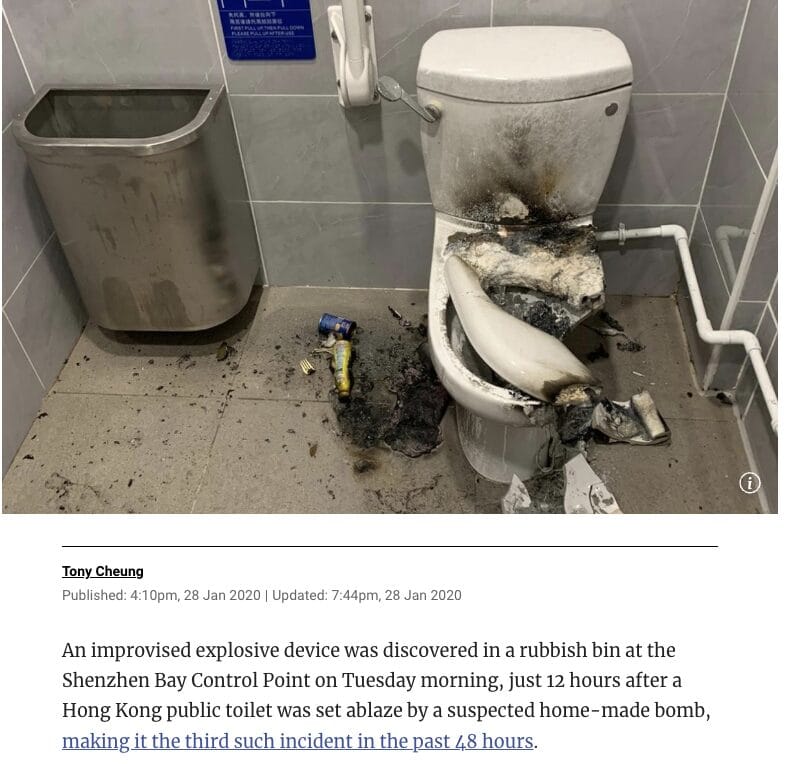
On the left side of the original photo you can see a sign that was cropped out in posts about the explosions in Lebanon. The inscriptions on this sign are in Chinese.
Thus, the photo of the toilet, distributed with captions that it was taken in Lebanon during the days of mass explosions of pagers and walkie-talkies, has in fact been available on the Internet for more than four years.
Intercom
Telegram channels also distributed a photo of an intercom that exploded in Lebanon (according to another version, a biometric lock), and some also clarified that all devices with lithium-ion batteries in the country detonated. Similar publications appeared in the channels “Nevzorov"(573,000 views), "RT in Russian"(200,000), "Ukraine 24/7"(130,000), "War on fakes"(105,000), etc.
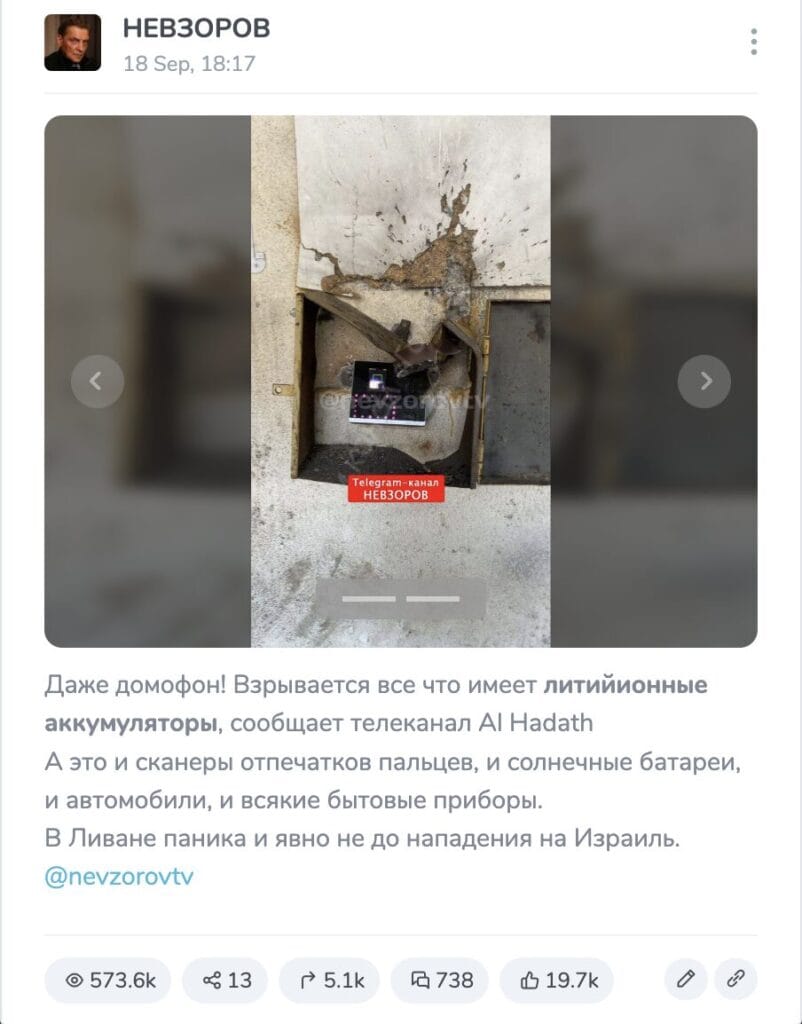
Publicist Alexander Nevzorov and some other bloggers refer to the Saudi TV channel Al Hadath, but “Verified” could not find publications on its website that all devices with lithium-ion batteries exploded in Lebanon. Al Arabia TV channel, which included into one media group with Al Hadath, conveyedthat reports are circulating that a biometric fingerprint reader has exploded. However, there are no reports on the TV channel’s website that the explosions affect all devices with lithium-ion batteries in Lebanon. In another Al Arabiya publication with reference to Reuters leads assessment by lithium-ion battery safety expert Paul Christensen of Newcastle University, who said that based on credible images from Lebanon, the damage to the device was not consistent with previous cases of such batteries failing.
Lithium-ion batteries apply in mobile phones, laptops, electric scooters and other devices. If misused, damaged or overcharged, they can overheat and cause what is called thermal runaway, leading to a fire or explosion. However, experts such as Trevor Lawrence, a former British Army ammunition technical officer, thinkthat the consequences of pager explosions in Lebanon are much greater than in the case of a regular battery fire.
A more likely possibility is that pagers and other devices were modified during production or delivery. Lebanese security services claimthat they could have been filled with explosives. According to Deutsche WelleHezbollah is investigating whether small amounts of pentaerythritol tetranitrate or RDX were used as explosives. Experts notethat the simple design of the pager already included some of the components necessary to create a homemade bomb, and all that would have been required was the addition of an explosive and a detonator, making it possible for all devices to be triggered accurately and simultaneously.
As for the image being verified, in this case, unlike the previous two, “Verified” did not find publications containing it that appeared before September 18. Photograph published including the Lebanese media with reference to their correspondent. However, judging by the photo, if an explosion did occur, it was not caused by overheating of the sensor’s lithium-ion battery, because the device itself remained intact. Apparently, some device on the outside of the protective shield exploded.
Thus, at the moment there is no reliable evidence that devices with lithium-ion batteries exploded en masse in Lebanon at the same time as pagers and walkie-talkies. The photo of the biometric lock used as evidence appears to have been taken in that country in September 2024, but the device itself was not damaged. The explosion probably occurred in the immediate vicinity of a protective box on which a pager or walkie-talkie could have been placed.
Cover: social networks
- Deutsche Welle. Fact check: No iPhones or solar panels exploded in Lebanon
- Is it true that the first secretary of the Ukrainian Embassy was wounded in a pager explosion in Lebanon?
- Is it true that this video shows one of the Iranian drones attempting to attack Israel?
If you find a spelling or grammatical error, please let us know by highlighting the error text and clicking Ctrl+Enter.


